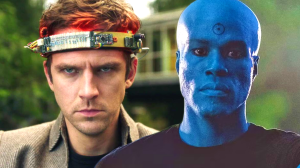With just seven episodes in its first season, AMC’s Interview With the Vampire reaches its midpoint this week with episode 4, “The Ruthless Pursuit of Blood With All a Child’s Demanding”, but in many ways the series is just getting started. Not only has the series already been renewed for a second season, but series showrunner Rolin Jones has said that the first season will only cover the first half of Anne Rice’s iconic novel, leaving a lot more story to tell.
Videos by ComicBook.com
Part of telling that story has included making some changes. While ahead of the series’ debut executive producer Mark Johnson said that he felt like the show was “truer to the book” than the 1994 film adaptation, whose screenplay was written by Rice herself, Interview With the Vampire has made some notable changes to Rice’s beloved novel as it reimagines the tale. While a few of the shifts have been obvious for fans of the novels well before the series arrived — changing the time period of Louis’ human life and the shift in race for a few key characters being the most notable — there are quite a few additional changes as well that in many ways makes AMC’s series almost an original creation. We’ve compiled some of the biggest changes from page to screen with Interview With the Vampire half way through the first season.
The Setting
Possibly the biggest change from page to screen is the setting — and we don’t mean in terms of Louis’ human life. In the novel, the “interview” between Daniel Molloy and Louis takes place in San Francisco in the 1970s making it contemporary to the time of its publication in 1976. However, the AMC series sets the novel in the present day, even referencing the COVID-19 pandemic, and shifts the actual “interview” to a penthouse in Dubai where Louis is now living. Additionally, the interview is a second take, a do-over of sorts between a much older and more seasoned Daniel and a Louis who is at a different place in his own immortality.
These changes are on top of the time shift in Louis’ human life, which is updated from the late 1700s Louisiana to 1910s New Orleans. That time shift will also have further story impacts down the road as events in the novel that took place in the 1800s will now take place at various points in the 20th century.
Claudia’s Age and Origin
A major difference between the book and the series is Claudia, specifically her age and her origin. In the novel, Claudia is a five-year-old child who a frenzied Louis finds — and feeds from — as she lies huddled next to the body of her deceased mother. Lestat witnesses this and mocks Louis, who runs off and leaves the nameless child for dead. Sick with plague and weak from being fed upon, she’s later taken by concerned citizens to a hospital for orphans, though Lestat pretends to be her father and takes her from there, bringing her home with him and turning her into a vampire much to Louis’ horror.
In the series, Claudia is a teen. Like her novel counterpart, Claudia’s mother is dead, though in the series Louis finds her trapped in a room in a burning boarding house in Storyville with her aunt and caretaker already burned to death just on the other side of the door. Louis, guilt-stricken that the burning of Storyville is his fault due to his murder of Alderman Fenwick, rescues her and brings her back to the townhouse he shares with Lestat. She’s badly burned and presumably dying, and Louis begs Lestat to turn her. Realizing that the creation of Claudia as a vampire would give them a daughter and, thus, keep Louis with him, Lestat turns Claudia into a vampire.
Louis and Lestat’s Initial Relationship
While there is no doubt that even within Rice’s Vampire Chronicles that Lestat and Louis do share a love story of sorts, how it begins on the page is very different than how it is shown on screen — and is even different depending on which vampire you ask.
In the novel, Louis is devastated by the death of his brother, Paul, and finds himself behaving in a self-destructive fashion and wanting to die. He’s attacked by Lestat in an alley outside his home and nearly drained of his blood. Louis survives, but the next evening Louis returns and, in Louis’ telling of the tale, gives him eternal life as a vampire in exchange for his wealth and plantation. Yes, you read that correctly: in the. novel from Louis’ perspective, Lestat initially only wanted Louis for his money. Later, however, in The Vampire Lestat, Lestat gets to tell his version of the story and reveals a very different perspective on their meeting, stating instead that he “fell fatally in love with Louis” and that making him a vampire had nothing to do with his fortune.
In the series, while we do see Lestat pursue Louis, it certainly seems to align more with Lestat’s version of things with the pair’s relationship turning romantic nearly from the start and there being no hint of any concerns regarding money. Additionally, Lestat has a more protracted relationship with the human Louis in the series, rather than coming to him after the death of Paul.
Interestingly what remains largely unchanged between both versions is that Louis fundamentally chooses his transition to the life of a vampire, in a sense, as the series shows Lestat offering Louis eternal life not in exchange for wealth but as a way to escape his human life of shame.
Lestat’s Age
Technically, it’s not Lestat’s actual age that is the difference between page and screen, but the difference in age between Louis and Lestat.
In the novels, Lestat is born in 1760 in France. This age holds in the television series — it’s noted that Lestat is around 159 years old several years after he and Louis come to be together which would put the year of his human birth around 1760 — but it’s the gap in their ages that is different.
In the novel, Louis is just six years younger than Lestat, having been born in 1766 and is turned to a vampire by Lestat in 1791 at the age of 25. What this means is that Lestat hasn’t been a vampire for very long himself when he turns Louis — and as readers find out, as his own maker killed themselves immediately upon turning Lestat, leaving the fledgling little knowledge of what he has become, but a massive amount of wealth.
The Absence of Lestat’s Father
One of the components of the novel that is entirely absent from the series is Lestat’s father. In the novel, Louis tells the reporter that Lestat wanted his plantation and fortune to care for his blind, aged father. It is Lestat’s father’s death (Lestat tells Louis to kill the old man as his condition severely worsens) that leads to the slaves on Louis’ plantation growing suspicious of the pair, which causes them to have to flee. Given that in the series Lestat is already more than a hundred years old when we meet him, Lestat’s father simply does not factor in.
Daniel’s Age and Experience
Another major shift from page to screen is Daniel’s age and experience. In the novel, the reporter is young and fresh in his career. He also is never referred to by name and is instead simply referred to as “the boy”. However, in the series, we get a much older version of the reporter, one who has plenty of both life and professional experience.
One thing that the series does that is interesting is that it treats Daniel’s experience in the novel as something of historical record. The series establishes that the “novel” happened as a first interview that ended badly — we even see the scars of a bite mark on Daniel’s neck. In the novel, at the end of the interview, Daniel asks Louis to turn him into a vampire as well, which prompts Louis to attack and feed from him and then leave him behind, though that only prompts Daniel to then seek out Lestat. It will be interesting to see how the series addresses Daniel’s journey given this new take on things.
Perspective
As a novel, Interview With the Vampire is simply the perspective of one character — Louis. The television series, however, offers a wider range of perspective. While the series is still told as Louis’ experience by way of a second interview with Daniel, not only does the series introduce another perspective to things by way of Claudia’s diaries (the series spends nearly all of episode 4 being told from the pages of her diary) but there are also moments where we see more fully fleshed out versions of the characters — particularly Lestat, who at moments appears more well-rounded than the monster Louis’ novel narrative often portrays him.
Part of that is indeed a product of changes made by the series to the story, particularly when it comes to Claudia, but it is also a product of the series being made now that Rice’s Vampire Chronicles series is complete. When the Interview With the Vampire film was made in the 1990s, there were only four books in the series available. Having access to the rest of the story allows the series to go a bit deeper into the characters even early on, as Lestat actor Sam Reid previously explained.
“I love the film. I love Tom Cruise’s performance in the movie, too,” Reid, who plays Lestat in AMC’s series told ComicBook.com. “But what we get to do is, when Anne wrote the second book, she sort of broke the character open a little bit and you understand a little bit more, brings in more backstory. And so, that’s what we’ve done. We’ve actually brought, this is the second interview that they have, in order for Louis to sort of have a bit more nuanced version of Lestat. So, I get to bring in all these fantastic elements that she sort of talks about in the books that you don’t really get to see in the movie because there’s only two hours and because it’s more based on that original book and we’re sort of looking at the whole universe. So, it’s super exciting.”
Interview With the Vampire airs Sundays at 10/9c on AMC.








